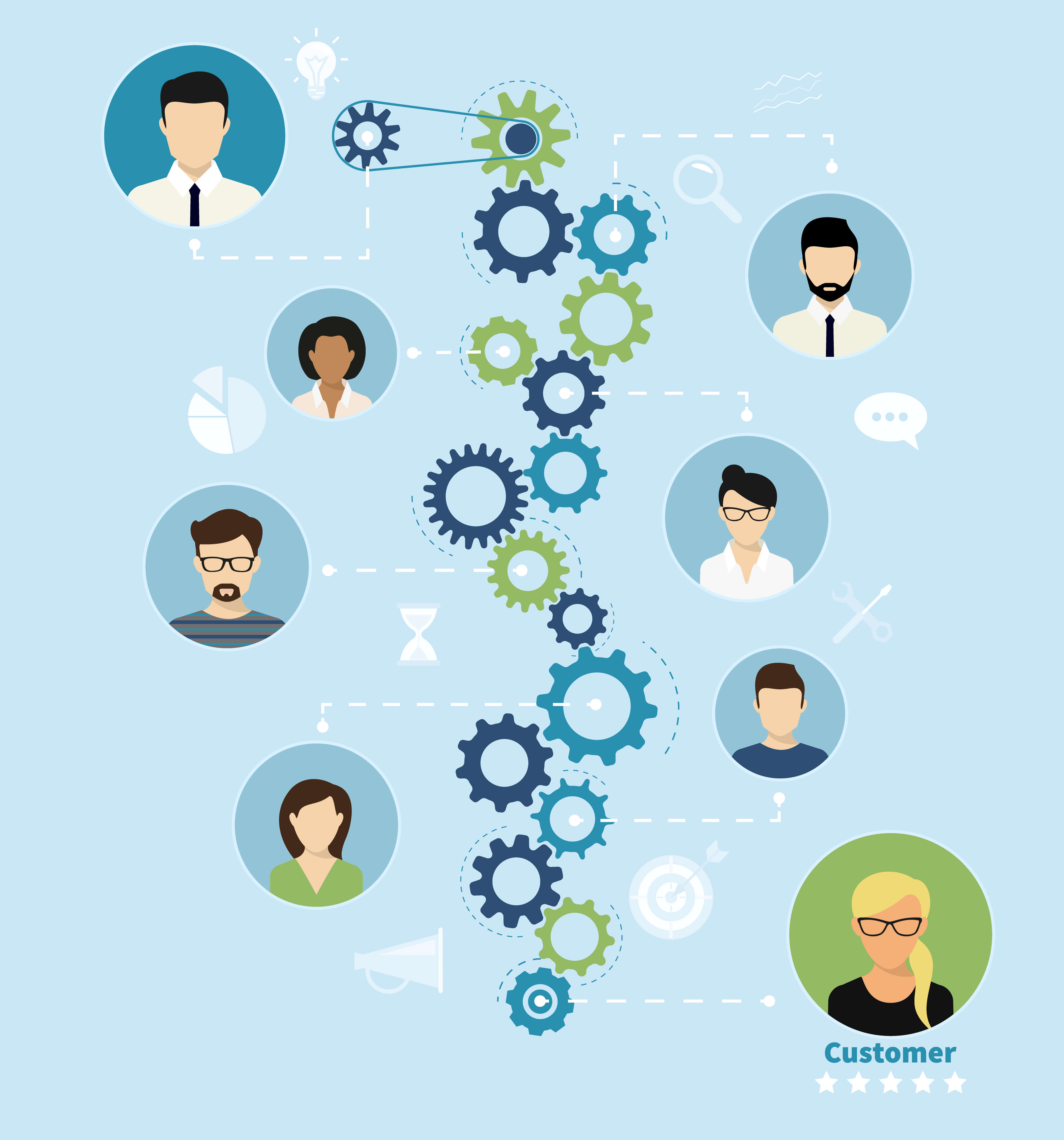Better B2B Customer Recruiting for Market Research

How important is B2B customer recruiting?
Well, when getting started with New Product Blueprinting, a common question is, “How long does a Blueprinting project take?” The answer is a very unsatisfying “It depends.” Yes… “it depends.” The biggest schedule item that “it depends” upon is the time to recruit customers. Truthfully, the rest of the Blueprinting process – from executing interviews to analyzing data – is not overly time-consuming. Therefore, if we become proficient in recruiting, we can execute projects quickly. And if we can execute quickly, we can accelerate our organic growth and innovation.
Though we speak of recruiting a “customer,” we sometimes instead use the market research term “respondent” since the word “customer” may actually be confusing. This, of course, is because we may interview a broader audience than just our own customers. Also, use of the word “respondent” reminds us that we are executing market research. Either term is fine and they can be used interchangeably.
Beginning the B2B Customer Recruiting Phase
As we get started, we have a fundamental question to answer, “Who should we interview?” To answer this question, we must ask ourselves an even more fundamental question, “Who are we innovating for?” This question can be phrased from various perspectives. Some examples:
- Whose life do we want to make better as a result of this project?
- Who has the problems that we wish to solve?
- Which person executes the job or task that we wish to improve?
- Who uses the product in our area of interest?
- What individuals of interest experience problems with our product?
- Who influences the purchase of the product?
Finally, once you’ve selected your B2B customer recruiting targets, it’s time to execute! Let’s look at nine best practices.
Nine Best Practices for B2B Customer Recruiting
1. Value relevance over sample size
For B2B customer recruiting, we can often get all the needs we need for Discovery Interviews with 8-12 respondents. However, this assumes that they have been chosen correctly! In 1936, The Literary Digest incorrectly predicted that Alfred Landon would defeat Franklin D. Roosevelt as president of the US. It made this error even with sample size of 2.4 million! Therefore, large numbers (no matter how large) cannot overcome a poorly chosen sample.

2. Include respondents along the value chain
Especially during Discovery Interviews, consider adding a customer’s customer or a channel partner to the list of respondents. This ensures that a need is not missed beyond the knowledge of our immediate customer.
3. Resolve to recruit at least some respondents with internal resources
In B2B, we aren’t just executing research, but we growing (or perhaps re-establishing) ties with customers. Therefore, when we recruit respondents ourselves, we are doing more than just learning their issues, we are continuing to build customer relationships.
4. Use outside recruiting resources if you get stuck
There are companies who can assist with B2B customer recruiting. They will work with you to create a screener and will line up interviews for you. This option makes more sense in less concentrated markets. One example is Field Work (www.fieldwork.com). Also, when exploring unfamiliar markets, consider a service such as Supporting Innovation (www.supportinginnovation.com) that can conduct background research to speed up your progress.
5. Get the sales team on board for B2B customer recruiting
The sales team is often the link between the project team and the customers. When on board, they can accelerate the recruiting process for the team. Additionally, when sales people are involved with Blueprinting, customers will perceive them in a more positive light – as part of a company that is truly concerned about their needs. To get the sales team on board, walk them through the site www.blueprintingforsales.com. This will answer common questions and provide a process overview.

6. Use a script for recruiting calls
A script is not necessarily something that one needs to read verbatim. Rather, it’s an outline of major points to cover in a recruiting call. Additionally, a script can help the recruiter overcome the fear of “what should I say?” Use the “Script Points for Interview Setup” job aid to reference the key points. Blueprinting practitioners will find all these resources within the Blueprinting Center.
7. Email an agenda to the respondent
When you send an agenda, the respondent will know that this is a professional, organized effort. A nice professional touch to your B2B customer recruiting. Additionally, this will help them to anticipate what the interview itself will be like. Reference the “Discovery Interview Agenda Template” BlueTool™.
8. Send the respondent to Haveyoubeendiscovered.com
This site answers the most common questions that respondents will have. It is also a good reference for the recruiter since these questions may come up during the call.

9. Start with a big list and make the calls!
B2B customer recruiting is a numbers game. The more calls you make, the more appointments you will get. Don’t get too worried about who says “yes” and who says “no.” Set aside some time and make many, many calls. The results will follow.
Finally, a note about your mindset for B2B customer recruiting.
When executing a Blueprinting project, you are doing your best to help those in your target market. Therefore, don’t feel like you’re begging them. Customers will soon realize that you are genuinely trying to help them – and will appreciate it. It will change the way they view you personally – and how they perceive your company. Besides, people really do love to talk about their problems – and the New Product Blueprinting process can be a catalyst to more than just successful new products, but to deeper customer relationships.
vidalista 20 tadalafil tablets does medicare cover cialis cialis indien bezahlung mit paypal
canadian pharmacy cialis 20mg: Tadal Access – how to get cialis without doctor
https://tadalaccess.com/# cialis coupon rite aid
where to get the best price on cialis TadalAccess cialis manufacturer coupon
cialis paypal canada: Tadal Access – online pharmacy cialis
https://clomhealth.com/# where to buy generic clomid without insurance
amoxicillin 30 capsules price amoxicillin price without insurance where can i get amoxicillin
amoxicillin 500mg capsules: Amo Health Care – Amo Health Care
https://clomhealth.com/# where can i buy cheap clomid without insurance
can i purchase clomid now: can i order cheap clomid tablets – where to buy cheap clomid without prescription
PredniHealth prednisone 10mg order prednisone with mastercard debit
can you get cheap clomid no prescription: Clom Health – clomid generics
can i buy generic clomid no prescription: cost of generic clomid pill – cost of clomid without insurance
prednisone 20mg for sale over the counter prednisone pills PredniHealth
https://amohealthcare.store/# Amo Health Care
PredniHealth: prednisone 10mg cost – PredniHealth
amoxicillin 875 mg tablet can i buy amoxicillin over the counter Amo Health Care
where buy generic clomid without rx: where to buy generic clomid pill – can i buy generic clomid online
https://amohealthcare.store/# Amo Health Care
get clomid without a prescription: Clom Health – how to buy clomid online
can i get clomid pills can i get clomid without rx clomid without rx
Amo Health Care: buy amoxil – Amo Health Care
https://clomhealth.com/# how to get clomid price
prednisone coupon: PredniHealth – prednisone 7.5 mg
PredniHealth: can i buy prednisone online without prescription – PredniHealth
Amo Health Care Amo Health Care amoxicillin online no prescription
https://clomhealth.com/# how to get generic clomid for sale
PredniHealth: PredniHealth – PredniHealth
clomid pill: cost of cheap clomid pills – can i purchase cheap clomid
prednisone rx coupon can you buy prednisone over the counter uk PredniHealth
http://prednihealth.com/# PredniHealth
Amo Health Care: Amo Health Care – where can you get amoxicillin
generic tadalafil affordable ED medication online Cialis pharmacy
https://maxviagramd.com/# discreet shipping
buy generic Cialis online: discreet shipping ED pills – cheap Cialis online
buy generic Viagra online: buy generic Viagra online – trusted Viagra suppliers
safe online pharmacy best price for Viagra discreet shipping
http://modafinilmd.store/# modafinil 2025
Cialis without prescription: generic tadalafil – order Cialis online no prescription
modafinil legality: buy modafinil online – safe modafinil purchase
safe modafinil purchase modafinil pharmacy verified Modafinil vendors
https://zipgenericmd.shop/# affordable ED medication
affordable ED medication: reliable online pharmacy Cialis – buy generic Cialis online
best price Cialis tablets: FDA approved generic Cialis – secure checkout ED drugs
modafinil legality legal Modafinil purchase modafinil legality
discreet shipping ED pills: buy generic Cialis online – cheap Cialis online
http://zipgenericmd.com/# best price Cialis tablets
buy modafinil online: legal Modafinil purchase – legal Modafinil purchase
secure checkout Viagra: buy generic Viagra online – no doctor visit required
secure checkout ED drugs: generic tadalafil – reliable online pharmacy Cialis
modafinil pharmacy purchase Modafinil without prescription buy modafinil online
https://maxviagramd.shop/# no doctor visit required
trusted Viagra suppliers: generic sildenafil 100mg – order Viagra discreetly
modafinil pharmacy: Modafinil for sale – modafinil legality
modafinil pharmacy modafinil pharmacy doctor-reviewed advice
Modafinil for sale: modafinil 2025 – modafinil pharmacy
https://zipgenericmd.shop/# FDA approved generic Cialis
buy generic Viagra online: cheap Viagra online – trusted Viagra suppliers
discreet shipping ED pills: secure checkout ED drugs – FDA approved generic Cialis
buy generic Cialis online FDA approved generic Cialis order Cialis online no prescription
http://maxviagramd.com/# same-day Viagra shipping
fast Viagra delivery: trusted Viagra suppliers – no doctor visit required
fast Viagra delivery: generic sildenafil 100mg – same-day Viagra shipping
modafinil legality: modafinil 2025 – verified Modafinil vendors
Viagra without prescription buy generic Viagra online discreet shipping
online Cialis pharmacy: online Cialis pharmacy – secure checkout ED drugs
https://zipgenericmd.com/# Cialis without prescription
Modafinil for sale: modafinil 2025 – modafinil 2025
modafinil legality verified Modafinil vendors modafinil legality
Cialis without prescription: cheap Cialis online – discreet shipping ED pills
modafinil pharmacy: modafinil legality – doctor-reviewed advice
Thanks for sharing. I read many of your blog posts, cool, your blog is very good.
online Cialis pharmacy: secure checkout ED drugs – generic tadalafil
buy modafinil online modafinil legality verified Modafinil vendors
cheap Viagra online: safe online pharmacy – safe online pharmacy
generic sildenafil 100mg: legit Viagra online – same-day Viagra shipping
order Cialis online no prescription generic tadalafil secure checkout ED drugs
same-day Viagra shipping: best price for Viagra – trusted Viagra suppliers
doctor-reviewed advice: modafinil pharmacy – safe modafinil purchase
cheap Viagra online legit Viagra online same-day Viagra shipping
best price for Viagra: cheap Viagra online – cheap Viagra online
https://pinupaz.top/# pin-up
пин ап казино: pin up вход – пин ап казино официальный сайт
вавада официальный сайт: вавада казино – вавада официальный сайт
pin up вход пин ап казино пин ап вход
http://pinupaz.top/# pinup az
pin up вход: пин ап вход – pin up вход
pin up вход: пин ап казино официальный сайт – pin up вход
http://pinupaz.top/# pin up azerbaycan
pin up azerbaycan pin up pin-up
pin up az: pinup az – pin up azerbaycan
пин ап казино официальный сайт: пин ап казино официальный сайт – пинап казино
pin up вход пин ап казино официальный сайт пин ап казино официальный сайт
вавада: вавада официальный сайт – вавада казино
pin-up: pin up – pin up
пин ап казино официальный сайт пин ап зеркало пин ап казино
pinup az: pin-up – pin-up
pinup az: pin up azerbaycan – pinup az
pin-up casino giris pin-up casino giris pinup az
vavada: вавада официальный сайт – вавада официальный сайт
pinup az: pin up az – pin up
pin up pin-up casino giris pin up az
пин ап казино: пин ап казино – пинап казино
вавада казино: vavada casino – вавада официальный сайт
пин ап вход: пинап казино – пин ап зеркало
pin up az pin up pin up azerbaycan
vavada вход: вавада – vavada casino
пин ап вход pin up вход пин ап зеркало
http://pinupaz.top/# pin-up casino giris
вавада казино: vavada casino – vavada casino
вавада казино: вавада казино – vavada вход
pin-up casino giris pin up az pin-up
https://pinuprus.pro/# пин ап казино
vavada вход: vavada – vavada casino
pin up: pin-up – pin up casino
vavada vavada вавада
vavada вход: vavada вход – vavada casino
пин ап зеркало: пин ап вход – пин ап казино
пин ап казино официальный сайт пин ап казино официальный сайт pin up вход
pin up casino: pin-up casino giris – pin up az
пин ап зеркало: пин ап вход – пин ап казино
вавада официальный сайт вавада vavada вход
вавада казино: вавада казино – vavada
vavada вход: vavada – вавада официальный сайт
pinup az pinup az pin-up
pin-up casino giris: pin up – pin up casino
pinup az: pin up az – pin up
vavada vavada вход вавада казино
pin-up casino giris: pin up az – pin-up
вавада официальный сайт: вавада официальный сайт – vavada casino
pinup az: pinup az – pin up azerbaycan
pin up az pin up az pin up azerbaycan
пин ап казино: пинап казино – пин ап казино официальный сайт
pin-up: pin-up casino giris – pin up
вавада vavada casino vavada
пин ап казино: пин ап казино официальный сайт – пинап казино
вавада казино: vavada вход – vavada вход
pin-up pin-up pin-up casino giris
pin up casino: pinup az – pin up az
pin up: pin-up casino giris – pin up azerbaycan
pin-up casino giris pin up casino pin up az
pin up casino: pin up az – pinup az
пин ап казино: pin up вход – пин ап казино официальный сайт
пин ап вход пин ап зеркало пин ап казино официальный сайт
пин ап зеркало: pin up вход – пин ап зеркало
pin up casino: pin up az – pin up az
пин ап казино: пин ап вход – пин ап вход
pin-up casino giris pinup az pin up azerbaycan
pinup az: pin up – pinup az
pin up casino: pin up azerbaycan – pinup az
pin up pin-up pinup az
pin-up casino giris: pin up casino – pin up azerbaycan
vavada casino: vavada – вавада зеркало
pin up вход: пин ап казино официальный сайт – пин ап казино
пинап казино пин ап казино официальный сайт pin up вход
pin up вход: пин ап зеркало – пин ап казино официальный сайт
пин ап казино официальный сайт: пин ап зеркало – пинап казино
pin up az pin-up pin up casino
pinup az: pin up – pinup az
pin up: pin-up casino giris – pinup az
пин ап вход: пин ап казино – пин ап казино официальный сайт
вавада казино вавада вавада казино
пин ап зеркало: пин ап казино официальный сайт – пин ап казино
pin-up casino giris: pinup az – pin up az
пин ап казино официальный сайт: пин ап зеркало – пинап казино
пин ап вход пин ап вход пин ап казино официальный сайт
пин ап зеркало: пин ап зеркало – пин ап вход
вавада казино: вавада официальный сайт – vavada вход
pin up: pinup az – pin-up casino giris
пин ап вход пин ап казино официальный сайт пин ап казино
pin up casino: pin up casino – pin up casino
пин ап казино: пин ап зеркало – пинап казино
пин ап казино официальный сайт: пин ап зеркало – пин ап казино официальный сайт
pin up вход pin up вход пин ап вход
pin-up: pin-up – pin-up casino giris
пинап казино: пин ап вход – пин ап казино официальный сайт
пин ап зеркало: пин ап вход – пин ап вход
pin up: pin-up – pin up az
пин ап зеркало pin up вход пинап казино
вавада официальный сайт: вавада официальный сайт – vavada casino
пин ап казино официальный сайт: пинап казино – пин ап казино официальный сайт
pin up: pin up azerbaycan – pin up casino
пин ап зеркало: пин ап казино официальный сайт – пин ап вход
pin up azerbaycan pin-up pin-up casino giris
пин ап вход: pin up вход – пин ап зеркало
пин ап зеркало: пин ап казино – пин ап казино
vavada вход: вавада – vavada casino
пинап казино пин ап казино официальный сайт пин ап казино официальный сайт
vavada вход: vavada вход – вавада
вавада официальный сайт: vavada вход – вавада официальный сайт
pin up casino: pin up az – pin-up casino giris
pin up pin-up pin up az
pin-up: pin up azerbaycan – pin-up
pin up вход: пин ап казино – пин ап казино официальный сайт
pin up вход: пин ап казино – pin up вход
пин ап зеркало пин ап вход пин ап зеркало
vavada вход: вавада зеркало – вавада
пин ап зеркало: пин ап вход – пин ап казино официальный сайт
пин ап зеркало: pin up вход – пин ап зеркало
pin up az pin-up pin up casino
pin up вход: пин ап вход – пин ап казино официальный сайт
pin up az: pin-up – pin up casino
pin-up pin-up casino giris pinup az
pin up: pin up azerbaycan – pin-up casino giris
pin up casino: pin up casino – pin-up casino giris
vavada casino vavada casino вавада официальный сайт
pin-up: pin up az – pin up
пинап казино: пин ап вход – пин ап вход
indian pharmacy online shopping: Medicine From India – Medicine From India
canadadrugpharmacy com: ExpressRxCanada – canadian pharmacy
mexico drug stores pharmacies Rx Express Mexico Rx Express Mexico
Rx Express Mexico: Rx Express Mexico – best online pharmacies in mexico
MedicineFromIndia: indian pharmacy online – indian pharmacy
mexican online pharmacy Rx Express Mexico mexico pharmacies prescription drugs
Medicine From India: indian pharmacy – indian pharmacy online
RxExpressMexico: mexico drug stores pharmacies – mexican rx online
mexico pharmacies prescription drugs: RxExpressMexico – buying from online mexican pharmacy
Rx Express Mexico mexican rx online mexico drug stores pharmacies
safe online pharmacies in canada: ExpressRxCanada – escrow pharmacy canada
canadian pharmacies compare: Generic drugs from Canada – canadian mail order pharmacy
canadian pharmacy ed medications: Generic drugs from Canada – best canadian pharmacy
Medicine From India: top 10 pharmacies in india – medicine courier from India to USA
legal canadian pharmacy online Buy medicine from Canada cross border pharmacy canada
canadian drug stores: Canadian pharmacy shipping to USA – vipps canadian pharmacy
reddit canadian pharmacy: Canadian pharmacy shipping to USA – online pharmacy canada
mexican online pharmacy: mexican online pharmacy – best online pharmacies in mexico
canadian pharmacy king reviews Express Rx Canada canadianpharmacymeds com
Medicine From India: indian pharmacy online shopping – Medicine From India
canadian discount pharmacy: Buy medicine from Canada – pharmacies in canada that ship to the us
indian pharmacy online: indian pharmacy – Medicine From India
canada rx pharmacy Express Rx Canada canada drugs online review
medicine courier from India to USA: indian pharmacy online shopping – MedicineFromIndia
Rx Express Mexico: mexico drug stores pharmacies – Rx Express Mexico
indian pharmacy online shopping: indian pharmacy online – cheapest online pharmacy india
real canadian pharmacy: Buy medicine from Canada – canadian pharmacy sarasota
indian pharmacies safe: Medicine From India – MedicineFromIndia
indian pharmacy online shopping Medicine From India indian pharmacy
mexican online pharmacy: Rx Express Mexico – mexico drug stores pharmacies
canadian pharmacy meds reviews: Buy medicine from Canada – vipps canadian pharmacy
RxExpressMexico: mexico drug stores pharmacies – mexico pharmacies prescription drugs
legitimate canadian pharmacy online Generic drugs from Canada canadian pharmacy near me
mexico pharmacy order online: mexico pharmacies prescription drugs – mexican rx online
Acheter Kamagra site fiable: Kamagra pharmacie en ligne – achat kamagra
cialis sans ordonnance: cialis generique – Cialis en ligne tadalmed.shop
Kamagra pharmacie en ligne: Achetez vos kamagra medicaments – kamagra 100mg prix
Tadalafil sans ordonnance en ligne cialis generique Cialis sans ordonnance 24h tadalmed.com
kamagra oral jelly: achat kamagra – Acheter Kamagra site fiable
Achetez vos kamagra medicaments: Kamagra Oral Jelly pas cher – kamagra livraison 24h
kamagra en ligne: kamagra oral jelly – kamagra 100mg prix
acheter kamagra site fiable: kamagra 100mg prix – kamagra en ligne
pharmacie en ligne livraison europe: Pharmacies en ligne certifiees – pharmacie en ligne fiable pharmafst.com
Acheter Kamagra site fiable: Kamagra Oral Jelly pas cher – kamagra oral jelly
Acheter Cialis 20 mg pas cher: cialis prix – Cialis en ligne tadalmed.shop
Kamagra pharmacie en ligne: kamagra 100mg prix – kamagra livraison 24h
acheter kamagra site fiable: Achetez vos kamagra medicaments – Kamagra pharmacie en ligne
Tadalafil 20 mg prix sans ordonnance Tadalafil achat en ligne Cialis sans ordonnance 24h tadalmed.com
Cialis sans ordonnance 24h: Tadalafil achat en ligne – Tadalafil achat en ligne tadalmed.shop
pharmacie en ligne: Medicaments en ligne livres en 24h – Pharmacie en ligne livraison Europe pharmafst.com
kamagra livraison 24h: kamagra gel – Acheter Kamagra site fiable
pharmacie en ligne france fiable: pharmacie en ligne – Pharmacie en ligne livraison Europe pharmafst.com
Tadalafil 20 mg prix sans ordonnance Tadalafil achat en ligne Pharmacie en ligne Cialis sans ordonnance tadalmed.com
Achat Cialis en ligne fiable: cialis prix – Cialis sans ordonnance pas cher tadalmed.shop
Pharmacie Internationale en ligne: pharmacie en ligne pas cher – pharmacie en ligne france livraison belgique pharmafst.com
kamagra oral jelly: acheter kamagra site fiable – kamagra oral jelly
http://pharmafst.com/# pharmacie en ligne france livraison belgique
pharmacie en ligne france pas cher pharmacie en ligne pas cher trouver un mГ©dicament en pharmacie pharmafst.shop
kamagra pas cher: achat kamagra – kamagra livraison 24h
pharmacie en ligne france livraison belgique: pharmacie en ligne – pharmacies en ligne certifiГ©es pharmafst.com
kamagra livraison 24h: Achetez vos kamagra medicaments – Achetez vos kamagra medicaments
https://tadalmed.shop/# Cialis generique prix
pharmacie en ligne livraison europe pharmacie en ligne pharmacie en ligne avec ordonnance pharmafst.shop
kamagra oral jelly: kamagra en ligne – kamagra pas cher
pharmacies en ligne certifiГ©es: Medicaments en ligne livres en 24h – pharmacie en ligne fiable pharmafst.com
Cialis generique prix: Acheter Cialis 20 mg pas cher – Achat Cialis en ligne fiable tadalmed.shop
pharmacie en ligne avec ordonnance: pharmacie en ligne sans ordonnance – Achat mГ©dicament en ligne fiable pharmafst.com
cialis prix: Cialis sans ordonnance 24h – Acheter Cialis tadalmed.shop
Pharmacie en ligne Cialis sans ordonnance cialis generique Acheter Cialis 20 mg pas cher tadalmed.com
Cialis generique prix: Tadalafil 20 mg prix en pharmacie – Cialis generique prix tadalmed.shop
Acheter Kamagra site fiable: kamagra pas cher – kamagra en ligne
kamagra livraison 24h: achat kamagra – kamagra livraison 24h
Pharmacie en ligne Cialis sans ordonnance cialis prix Achat Cialis en ligne fiable tadalmed.com
vente de mГ©dicament en ligne: pharmacie en ligne – Achat mГ©dicament en ligne fiable pharmafst.com
Kamagra Commander maintenant: achat kamagra – kamagra 100mg prix
Pharmacie Internationale en ligne: pharmacie en ligne pas cher – trouver un mГ©dicament en pharmacie pharmafst.com
kamagra pas cher: kamagra oral jelly – kamagra oral jelly
kamagra 100mg prix Acheter Kamagra site fiable achat kamagra
kamagra pas cher: achat kamagra – kamagra en ligne
kamagra en ligne: Acheter Kamagra site fiable – Acheter Kamagra site fiable
pharmacie en ligne france fiable: Meilleure pharmacie en ligne – pharmacie en ligne france livraison belgique pharmafst.com
Kamagra Oral Jelly pas cher kamagra pas cher kamagra oral jelly
Acheter Cialis: Cialis sans ordonnance 24h – Tadalafil achat en ligne tadalmed.shop
kamagra 100mg prix: kamagra oral jelly – Kamagra pharmacie en ligne
casino olympe: olympe casino en ligne – olympe casino cresus
Nice blog. Found this while searching through